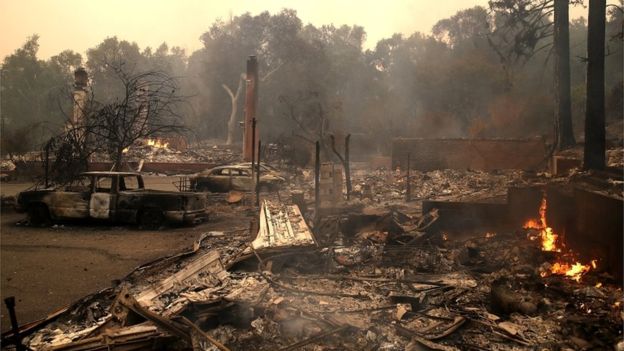Catastrophe risk modelling specialist RMS is hoping to enhance the insurance and reinsurance industries view of U.S. wildfire risks with a new high-definition risk model that was launched last week.
 After the severe California wildfire losses of 2017 and 2018 the subject of wildfire risk, the market’s ability to underwrite it accurately and whether the risk models are up to the job has been a topic of conversation in insurance, reinsurance and insurance-linked securities (ILS) circles.
After the severe California wildfire losses of 2017 and 2018 the subject of wildfire risk, the market’s ability to underwrite it accurately and whether the risk models are up to the job has been a topic of conversation in insurance, reinsurance and insurance-linked securities (ILS) circles.
RMS’ timing with its new risk model is ideal, given many U.S. wildfire exposed property catastrophe treaties will come up for renewal at the mid-year reinsurance contract signings.
The company calls its RMS U.S. Wildfire High Definition (HD) Model “the most comprehensive solution available for addressing wildfire risk across the Contiguous United States.”
Insurance and reinsurance industry losses from wildfires since just 2014 are likely to reach $30 billion, with around $17 billion delivered by 2018 California fires alone.
In fact, five of the 10 most destructive wildfires ever have occurred in 2017 and 2018 driving significant impacts to insurance, reinsurance and ILS fund interests.
RMS says these severe wildfire seasons, “Demonstrated the critical need for more advanced tools, more granular analytics, and broader geographic coverage in today’s risk modeling solutions.”
The recent wildfires have demonstrated deficiencies in some wildfire risk model tools, RMS explains, with inadequate zoning information and mapping often an issue, alongside a failure to account for vulnerabilities within structures, a lack of insight to identify the risk of urban conflagrations, low-resolution, and a lack of probabilistic insight, all cited as issues.
The new RMS U.S. Wildfire HD Model captures wildfire risks at high-resolution, enabling analysis of the way fires spread, ember accumulation, and smoke dispersion in an “unprecedented” way, RMS said.
The wildfire risk model simulates more than 18 million wildfires across the contiguous U.S. and allows users to adopt a more granular and comprehensive approach to underwriting and portfolio management of this risk.
“The past five years have demonstrated that the industry needs better ways to manage their wildfire risk comprehensively: for underwriting, for reinsurance purchasing, and for capital management,” commented Chris Folkman, Senior Director of Product Management at RMS.
“After three consecutive seasons with major cat events, it’s clear that wildfire needs to be treated more like a peak peril and less like a simple matter of attritional loss. Wildfire risk has a steep gradient, where different houses in the same neighborhood can have drastically different risk profiles. We’re confident our analytics can equip property writers to price, underwrite, and deploy capital with precision – for any Contiguous U.S. location,” Folkman continued.
RMS worked closely with top insurers, mitigation experts, and government agencies in developing this risk model, ensuring that the data, calibration, and scope of the model addresses current market gaps.
Hundreds of millions of dollars of granular claims data was used to help inform the calibration of 13 site-level adjustment features, RMS said, as well as featuring an explicit simulation of ember travel that RMS says goes beyond traditional fuel-cased fire techniques.
Anne D. Cope, Ph.D., P.E., Insurance Institute for Business & Home Safety (IBHS) Chief Engineer, commented, “IBHS is proud to have partnered with RMS in their development of a wildfire solution that includes relevant risk factors like explicit ember modeling while also capturing the latest data from the 2017 and 2018 wildfire seasons. The RMS Wildfire model is an important tool towards ensuring that wildfire risk can be confidently understood across the (re)insurance industry.”
Anneliese Jivan, President of The California Fair Access to Insurance Requirements (“FAIR”) Plan, added, “With the increasing number of severe wildfires in the U.S., understanding the impact of fire mitigation has never been more important. We’re hopeful that our collaboration with RMS in the development of their wildfire model will enable better industry data collection practices and a more active focus on home fire safety.”
After the losses of the last two years insurance and reinsurance underwriters, as well as risk capital providers, will be looking to improve their visibility and analysis of the wildfire risks they assume, in order to better inform their pricing, moderate their risk appetite and ensure they are being paid commensurate with the wildfire risks they are taking on.
If more of the wildfire peril is going to make its way into ILS markets, through collateralised reinsurance or catastrophe bonds, better risk modelling tools are going to be key to helping fund managers and underwriters get comfortable with this risk.
 View all of our Artemis Live video interviews and subscribe to our podcast.
View all of our Artemis Live video interviews and subscribe to our podcast.
All of our Artemis Live insurance-linked securities (ILS), catastrophe bonds and reinsurance video content and video interviews can be accessed online.
Our Artemis Live podcast can be subscribed to using the typical podcast services providers, including Apple, Google, Spotify and more.































